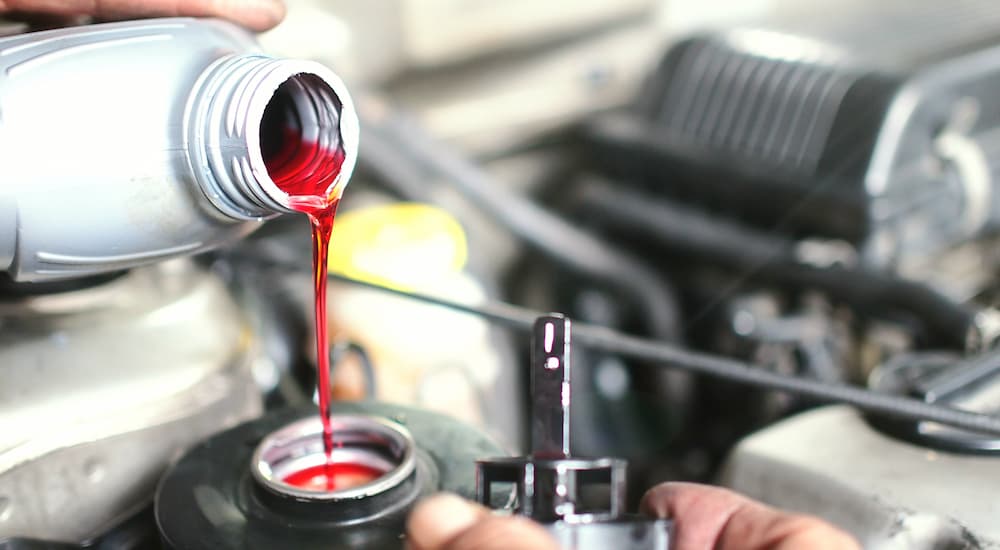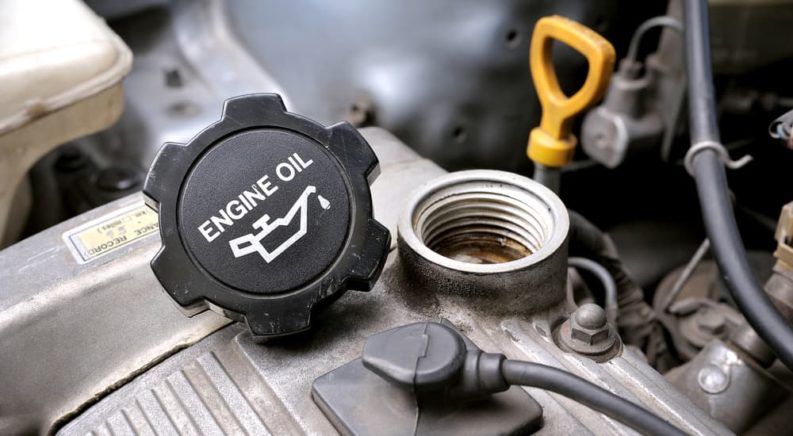Allow me to paint a picture for you: it’s 7 am on a Monday morning, you’re dragging hard from enjoying your weekend and running a bit late for work; you get to your car and notice a pool of strange, brown fluid slowly drying below your vehicle. Your first thought is a string of expletives; your second thought is, “What is leaking from my car!?” The bad news is that a fluid leak is never a good thing – but the good news is that identifying the fluid is relatively easy, and fixes for a leak can also be quite simple.
Today, I’m going to take you through the most common types of fluids that you’ll encounter leaking from your vehicle. We’ll cover the basic fluids in your car, what they look like, where you’ll typically find them from a leak, and what to do about it. At the end, I’ll toss in a cheat sheet based on fluid color, so you can jump down below if you’ve found strange liquid seeping from your ride and want to identify it quickly. By the end of this, you’ll be a fluid expert and ready to tackle anything your car throws at you – or leaks at you.
Safety First!
Before we go any further, it’s important that you understand something: the vast majority of fluids in your vehicle are potentially toxic and dangerous. You’re not going to die from looking at them or even touching them, but they can be very harmful and cause serious injuries if ingested or if they get into your eyes. You’ll see all sorts of manly men touch vehicle fluids or do repairs without gloves on, but this is always risky.
When you see fluids leaking from your vehicle and you’re trying to figure out what they are, it’s a good idea to put on gloves before touching the mystery liquid. Simple disposable gloves are perfect for this – if you insist on jabbing your bare finger into the fluid, then wash your hands very thoroughly afterward. It’s also a good idea to use a piece of white paper towel and dip it into the liquid to see its color more easily. Not only does this protect your skin, but the white towel makes it easy to judge the potentially subtle color of the fluids more accurately.
Engine Oil
Arguably, the most common fluid found under a vehicle when a leak occurs is motor oil or engine oil. This is found inside your vehicle’s engine, and it’s used to keep the moving parts of your engine properly lubricated so they can move without building up excess friction and heat. It’s one of the most important fluids in your vehicle, so an oil leak can mean your engine isn’t properly coated, and you could have serious issues occur.
Engine oil has an amber or golden-brown color when it’s fresh, but it darkens to a dark brown or even black as it gets older. Due to it being in your engine, these leaks are usually found at the front of your vehicle, just under where your engine sits. Oil leaks are usually inexpensive and simple to fix, especially if you catch them early and don’t ignore them. If you just had your oil changed and you find it leaking, take it back to that shop and have them check to make sure they fastened everything securely after they did the oil change.

Transmission Fluid
The transmission on your vehicle is responsible for controlling how the power created by the engine is sent to the wheels. It’s very important, and transmission fluid is necessary for your vehicle’s transmission to do its job. Because of how the transmission is set up in your car, these leaks are usually found more toward the center of your vehicle or toward the back of the front end. Transmission fluid looks similar to oil, but manufacturers add red dye to it to help you differentiate the two, and it has a smell similar to gasoline. You should have a transmission leak repaired as soon as possible, and try not to drive your car very much until you have it fixed.
Engine Coolant
The coolant in your engine does just what it sounds like: it helps keep your vehicle’s engine cool by flowing through it and taking heat away with it. Coolant is a fairly simple mixture of purified water and antifreeze, which helps prevent the water from freezing in the winter, so it will still function properly. Since the coolant and antifreeze are for your engine, you’ll find these leaks toward the front of your vehicle, though they’ll usually come from a reservoir off to the side of your engine. Coolant and antifreeze are brightly colored: you’ll find them in shades of red, green, orange, and pink; plus, they have a sweet scent to them.
Brake Fluid
One of the most important fluids in your vehicle, brake fluid is used to create hydraulic pressure in your car’s brake system. This is how the slight force you exert on the brake pedal is strong enough to bring your wheels, which are spinning very fast, to a stop. If your brake system doesn’t have enough fluid, then your brakes can feel squishy and soft – and your braking distance will increase.
Unfortunately, since your brakes lines run throughout your vehicle, a brake fluid leak can occur in numerous locations, and you can find the fluid anywhere under your car. Fresh brake fluid starts off a very transparent yellow but turns brown over time. It’s very slippery, however, which can help when trying to identify what you find leaking from your car. If you’re leaking brake fluid, then have your vehicle serviced immediately and drive it as little as possible.
Power Steering Fluid
This is one of the trickiest fluids to identify when you have a leak under your vehicle, though fortunately, it’s pretty rare (and getting rarer – most modern cars use electric power steering that doesn’t require fluid). The trouble comes from the fact that it looks a lot like transmission and brake fluid, so telling them apart can be tough. Power steering fluid is used to help make steering easier, and without it, you’ll often have to work a lot harder to get your vehicle to respond to turning the wheel. These leaks are typically found toward the front-end of your car; fresh power steering fluid is often red in color, and it turns brown as it gets older, which is why it can be hard to tell from other types.

Gasoline
Gas leaks are no joke, not only because you’re throwing money away at the fuel pump but also because they can be potentially dangerous. Fortunately, these are among the easiest leaks to identify since you’ll pretty easily recognize the smell of gasoline. Gas is golden brown or pale amber in color, but it’s distinguished by the rainbow effect that occurs when light hits it.
Water
This might not be the first thing that comes to mind, but it’s possible for the fluid you find under your vehicle to simply be water. This usually occurs due to condensation from your vehicle’s A/C unit, and in that case, it’s not really something to worry about. As you know, water is clear, odorless, and you’ll usually find these puddles just under your car where your A/C is designed to drain away excess water.
Quick Guide: Fluids by Color
Just trying to figure out what a fluid is quickly based on its color? I got you:
- Amber or Golden-Brown – Motor Oil, Brake Fluid, or Gasoline
- Dark Brown – Motor Oil, Brake Fluid, Power Steering Fluid
- Black – Motor Oil
- Reddish Brown – Transmission Fluid or Power Steering Fluid
- Bright Neon Colors – Coolant or Windshield Wiper Fluid
- Pale, Almost-Clear Yellow – Brake Fluid
- Rainbow Effect in Light – Gasoline
- Completely Clear – Water
Don’t Wait to Fix Leaks
Now that you have a sense of what’s leaking from your vehicle, it’s very important that you address the problem sooner rather than later. When you catch a leak early, the repair for it can be quick, easy, and relatively cheap. Waiting just leads to bigger problems that take longer and are far more expensive to have repaired. So don’t wait – do what’s best for your car, and it’ll treat you right for many years to come.

